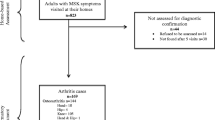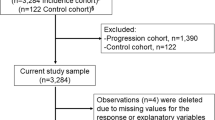Abstract
Arthritis and other rheumatic conditions comprise the leading cause of disability in the United States. In 1990, an estimated 16.7% of Missourians had arthritis. By 2020, an estimated 20% of Missourians will have this condition. We examined Missouri's prevalence of self- reported physician-diagnosed arthritis, chronic joint symptoms, and activity limitation due to joint symptoms and their associations with selected predictors (i.e., socio-demographic, access to health care, risk factor, and co-morbidity indicators) from Missouri's 1996 Behavioral Risk Factor Surveillance System. We conducted logistic regression analysis to generate Odds Ratios and 95% Confidence Intervals of arthritis and activity limitation across levels of predictors. Analysis indicates arthritis is under- diagnosed in younger individuals and that arthritis and activity limitation due to joint symptoms are significant contributors to functional limitation, enhancing dependency while decreasing the quality of life. As the population ages, arthritis, chronic joint symptoms, and activity limitation will become a larger public health problem.
Similar content being viewed by others
REFERENCES
Centers for Disease Control and Prevention. Prevalence and impact of chronic joint symptoms— seven states, 1996. Mor Mortal Wkly Rep. 1998; 47:345–350.
Centers for Disease Control and Prevention. Unrealized prevention opportunities: reducing the health and economic burden of chronic disease. A Report of the National Center for Chronic Disease Prevention and Health Promotion, 1998.
Yelin E, Callahan L. The economic cost and social and psychological impact of musculoskeletal conditions. Arthritis Rheum. 1995; 38:1351–1362.
Centers for Disease Control and Prevention. Arthritis Prevalence and activity limitations—United States, 1990. Mor Mortal Wkly Rep. 1994; 43:433–438.
Centers for Disease Control and Prevention. Prevalence and impact of arthritis accordingto racial group and Hispanic ethnicity—United States, 1989–1991. Mor Mortal Wkly Rep. 1996; 45:373–378.
Lorig K, Mazonson P, Holman H. Evidence suggesting that health education for self-management in patients with chronic arthritis has sustained health benefits while reducinghealth care costs. Arthritis Rheum.1993; 36:436–439.
Felson DT, Zhang Y, Anthony JM. Weight loss reduces the risk for symptomatic knee osteoarthritis in women. Ann Intern Med. 1992; 117:535–539.
Frazier EL, Franks AL, Sanderson LM. Behavioral Risk Factor Data. In Healthy People 2000: National Health Promotion and Disease Prevention Objectives. U.S. Department of Health and Human Services, publication no. (PHS)91-50213, 1990; pp. 4.1–4.17.
Remington PL, Smith MY, Williamson DF, Anda RF, Gentry EM, Hogelin GC. Design, Characteristics, and Usefulness of State-Based Behavioral Risk Factor Surveillance: 1981–87. Public Health Rep. 1988; 103(4):364–375.
Centers for Disease Control and Prevention. Health risks in America: gaining insight from the behavioral risk factor surveillance system. 1996. Behavioral Surveillance Branch, National Center for Chronic Disease Prevention and Health Promotion. Atlanta, GA.
Groves RM, Biemer PP, Lyberg LE, Massey JT, Nicholls II WL, Waksberg J, eds. Telephone Survey Methodology. 1988. John Wiley & Sons: New York.
Centers for Disease Control and Prevention. Prevalence of leisure-time physical activity among persons with arthritis and other rheumatic conditions—United States, 1990–1991. Mor Mortal Wkly Rep. 1997; 46:389–393.
Simoes EJ, Newschaffer CJ, Hagdrup N, et al. Predictors of Compliance with Recommended Cervical Cancer ScreeningSchedule: A Population-Based Study. J Community Health. 1999; 24(2): 115–130.
Helmick CG, Lawrence RC, Pollard RA, Lloyd E, Heyse SP. Arthritis and other rheumatic conditions: who is affected now, who will be affected later? Arthritis Care Res. 1995; 8(4):203–211.
Centers for Disease Control and Prevention. Prevalence and impact of arthritis amongwomen — United States, 1989–1991. Mor Mortal Wkly Rep. 1995; 44:329–334.
Centers for Disease Control and Prevention. Factors Associated with Prevalent Self-Reported Arthritis and Other Rheumatic Conditions—United States, 1989–1991. Mor Mortal Wkly Rep. 1996; 45:487–491.
Saag KG, Doebbeling BN, Rohrer JE, et al. Variation in tertiary prevention and health service utilization amongthe elderly: the role of urban-rural residence and supplemental insurance. Med Care. 1998; 36:965–976.
Hagen KB, Kvien TK, Bjorndal A. Musculoskeletal pain and quality of life in patients with noninflammatory joint pain compared to rheumatoid arthritis: a population survey. J Rheumatol. 1997; 24:1703–1709.
Seidell JC. Time trends in obesity: an epidemiological perspective. Horm Metab Res. 1997; 29: 155–158.
Verbrugge LM, Gates DM, Ike RW. Risk factors for disability among U.S. adults with arthritis. J Clin Epidemiol. 1991; 44(2):167–82.
Verbrugge LM, Lepkowski JM, Konkol LL. Levels of disability among U.S. adults with arthritis. J Gerontol. 1991; 46(2):S71–83.
Yelin E. Arthritis: The cumulative impact of a common chronic condition. Arthritis Rheum. 1992; 35(5):489–97.
Bradley EM. The impact of disablingarthritis. Arthritis Care Res. 1995; 8(4):221–8.
Miles TP, Flegal K, Harris T. Musculoskeletal disorders: time trends, comordid conditions, selfassessed health status, and associated activity limitation. Vital Health Stat 3. 1993; 27:275–288.
Bowlin SJ, Morrill BD, Nafziger AN, Jenkins PL, Lewis C, Pearson TA. Validity of cardiovascular disease risk factors assessed by telephone survey: the Behavioral Risk Factor Survey. J Clin Epidemiol. 1993; 46:561–571.
Brownson RC, Jackson-Thompson J, Wilkerson JC, Kiani F. Reliability of information on chronic disease risk factors collected in the Missouri Behavioral Risk Factor Surveillance System. Epidemiology. 1995; 5(5):545–549.
Author information
Authors and Affiliations
Rights and permissions
About this article
Cite this article
Vradenburg, J.A., Simoes, E.J., Jackson-Thompson, J. et al. The Prevalence of Arthritis and Activity Limitation and Their Predictors in Missouri. Journal of Community Health 27, 91–107 (2002). https://doi.org/10.1023/A:1014557016281
Issue Date:
DOI: https://doi.org/10.1023/A:1014557016281




